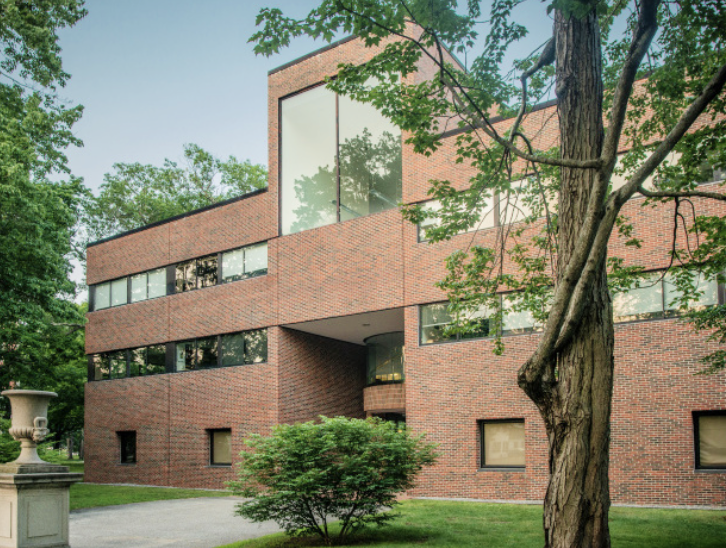
The Visual Arts Center was built in 1975. Edward Larrabee Barnes struggled with designing the new building because he needed to provide a space for the history of art and studio classes, a library, storage, picture, study, exhibitions, auditorium, studios, and office spaces.[1]
The VAC was an acquired space for art instruction which allowed for a more intimate study of the discipline. The Walker Art Building didn’t offer these spaces for formal instruction, so the VAC was an upgrade for the Art Department. Also, in 1975, the Art Department was separated into the History of Art and Visual Arts.
Thomas Cornell, who is pictured below was appointed as the chairman of the division of Visual Arts within the overall Art Department. What is also significant about is the book Cornell holds. It represents what has been taught in-studio classes historically. The course description of Painting I, reads: “Studio projects will entail objective observation and analysis of still like, landscape and figurative subjects…”[2]
Instruction:
Click on the highlighted sections of the photograph.
[drawattention ID=”386″]
The image on the left of Cornell appears to be a copy after a white plaster cast and then a still life on the left of that. The subject matter is what is most important here. Students in Bowdoin studio art courses are learning after the techniques of the master artists. Artists in Europe learned from studying the masters and looking back to idealized forms that emphasized Eurocentric ideals of beauty. They worked after white plaster casts, still life painting, and from life.

In Visual Arts courses, students historically, and currently, learned how to draw figuratively from life. In the portraiture unit, students learn from drawing other students. Students are learning, while everyone is gathered around in a circle, drawing the student who is in the center view from them. This demonstrates where and how they’re getting their experience in technical training. This is telling us that as students are learning from what the instructor gives them access to, whether it is each other or the statues and casts they have used for a few decades. These are all also taken in the VAC providing the viewer with a look into the classroom.
Ladson-Billings writes that her study of CRT:
“represents beginning look at the way teachers might systemically include student culture in the classroom as authorized or official knowledge”[3]
I argue that this doesn’t push far enough because, in the case of Bowdoin, these classrooms were filled with white students who are emerged into a Euro-American-focused curriculum in the Art Department; one can argue that that is CRT based on this claim Ladson-Billings’ claim. My research addresses that demographics shouldn’t solely determine the methods of teaching in a classroom because, at a PWI like Bowdoin, the majority is represented in coursework and curriculum. I argue that in studio art courses, no matter who you are you should be able to depict anyone despite their skin color or hair texture. This cannot be achieved with a narrow curriculum that continues to perpetuate these Eurocentric idealized forms of beauty. Students should be able to understand how darker skin absorbs more light and how to depict various textures of hair.
After going through the history of art and the environment and changes in the curricula from the chartering of Bowdoin college to the present, we are going to shift gears into our contemporary moment. The next section highlights voices of Black alumni who have gone through Bowdoin’s Visual Arts Department. Click the link below to read the next section A Short-Lived Boom of Black Art at Bowdoin.
[1] Calhoun, Charles C. A Small College in Maine: Two Hundred Years of Bowdoin. Brunswick, Me.: Bowdoin College, 1993.
[2] “Bowdoin College Catalogue (1986-1987).” Bowdoin Digital Commons. Accessed March 19, 2021. https://digitalcommons.bowdoin.edu/course-catalogues/268/.
[3] Ladson-Billings, Gloria. “Toward a Theory of Culturally Relevant Pedagogy.” American Educational Research Journal32, no. 3 (1995): 465–91. https://doi.org/10.3102/00028312032003465.